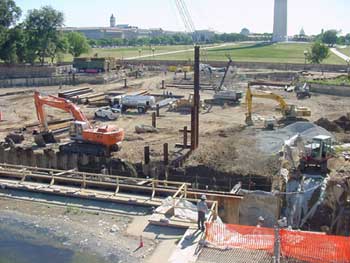 Art
ArtShifting our gaze downward toward the Lincoln Memorial, the WWII memorial construction site forms a discomforting counterpoint to the classical lines of the Reflecting Pool and the Monument itself. There is no single focal point, no salient feature that, like the statue of Lincoln, creates a visual axis. Instead there is a confusion of objects diffused by the two excavations where the two major elements of the future monument will stand. Indeed, most of the criticism of the monument's design, which could well have come from the desk of Albert Speer, has attacked it for interrupting the visual lines of the Mall.
The point of the war memorial, I suppose, is to conjure up the valor of American arms in the Second World War and link it visually to that of the Revolution and the Civil War. It is a fruit of the nostalgia that swept our country in the 1990s, when we were awash in retrospective profiles of "The Greatest Generation" and flocked to see Saving Private Ryan. The monument's purpose is essentially to plug Tom Hanks' character into the Republican tradition we have celebrated since the foundation of the Society of the Cincinnati in 1783: the citizen who selflessly takes up arms to serve the Republic. Hanks is Washington at Valley Forge. He is Joshua Lawrence Chamberlain at Little Round Top.
 Anxiety has undermined this project. The juxtaposition of the chaotic construction site with the obelisk and the Lincoln Memorial reveals the irony underlying the WWII monument as well as its connection to the Jersey barriers. It suggests that the haste to wrap ourselves in the memory of "The Greatest Generation" and have it visually ride piggy-back on the glory evoked by the Washington Monument and the Lincoln Memorial says more about our own anxieties than the achievements of our grandfathers. Our nation's most precious icons become mirrors that reflect our present insecurity.
Anxiety has undermined this project. The juxtaposition of the chaotic construction site with the obelisk and the Lincoln Memorial reveals the irony underlying the WWII monument as well as its connection to the Jersey barriers. It suggests that the haste to wrap ourselves in the memory of "The Greatest Generation" and have it visually ride piggy-back on the glory evoked by the Washington Monument and the Lincoln Memorial says more about our own anxieties than the achievements of our grandfathers. Our nation's most precious icons become mirrors that reflect our present insecurity.
Of course, Anxiety is real, not art, just as 9/11 was no coup de théatre. The danger in treating 9/11 as art, beyond anesthetizing oneself from the horror, is that it makes the attacks a primarily aesthetic act, like the Taliban's destruction of the Buddhist statues at Bamian. But the attack was not vandalism: it was mass murder. Not the sign of mass murder or 'mass murder' in postmodern quotation marks, but real mass murder. Also real is the danger from which those awful Jersey barriers are meant to protect the Monument (and the tourists who might be caught there) when a truck bomb shatters the peace of the Mall.
And yet, aesthetics count too; Hirst is right that visual language is one way in which power is communicated. I deeply regret that the Park Service cannot find a more encouraging response both to the security threat and to honoring World War II veterans, one that is more mindful of the fact that everything on the Mall becomes a part of the installation. I have seen defensive earthworks on the Franco-German border built by Vauban in the seventeenth-century, for example, that manage to articulate French power, rather than the deep-seated anxiety that prompted their construction in the first place. Fort McHenry, with its charming parapets (probably inspired by Vauban), is an example much closer to home. Thanks to Francis Scott Key, we now associate those low walls with triumph and valor rather than military vulnerability. We have no Vauban, alas, and no Key. Tom Ridge is unlikely to bring to his new job anything resembling artistic sensibility.



film politics music jay's head poetry art josh ring fysche saddies about archive